The Navajo-Gallup Water Supply Project is a major construction project being undertaken by the Bureau of Reclamation as part of the 2005 Navajo Nation Water Rights Settlement Agreement. With 300 miles of pipeline, two water treatment plants, 19 pumping plants, and numerous storage tanks spread across an area the size of New Jersey, the project will bring a clean and reliable surface-water supply to members of the Navajo Nation, some of whom currently do not have water directly delivered to their homes, as well as to beneficiaries in the Jicarilla Apache Nation and the City of Gallup.
Patrick Page, a deputy construction engineer with the Bureau of Reclamation, spoke with Municipal Water Leader writer Tyler Young about the history and details of the project, its significance, and how it is progressing today.
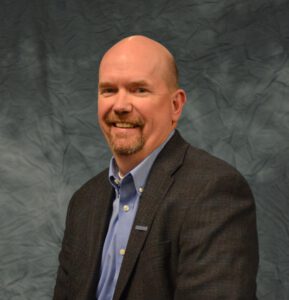 Tyler Young: Please tell us about your background in the water industry and about your time at Navajo-Gallup.
Tyler Young: Please tell us about your background in the water industry and about your time at Navajo-Gallup.
Patrick Page: I have been the deputy construction engineer for the Four Corners Construction Office of the Bureau of Reclamation in Farmington, New Mexico, since 2011, and in that capacity, I also serve as the project manager for the Navajo-Gallup Water Supply Project. Prior to that, I was the water management group chief in Reclamation’s Western Colorado Area Office in Durango, Colorado. I worked in that office for 21 years before I came down to New Mexico. During the last few years of my work in Colorado, I started working with Navajo-Gallup in some of the preconstruction agreements. Mainly, I was involved with the negotiation of the Navajo Settlement Agreement and Contract and the two repayment contracts we have. So, I have been involved with Navajo-Gallup now for over 10 years and have had the opportunity to work with the Navajo Nation and other tribes in the area pretty much my whole career.
Tyler Young: Would you provide a brief history of Navajo- Gallup Water Supply Project?
Patrick Page: Navajo-Gallup will provide a domestic, municipal, and industrial water supply to 43 chapters within the Navajo Nation, the southwestern portion of the Jicarilla Apache Reservation, and the City of Gallup. The concept of Navajo-Gallup has been around for decades, and has had various levels of support throughout the years. In 2009, the stars aligned when Public Law 111-11 authorized the construction of Navajo-Gallup and other elements of the Navajo Nation Water Rights Settlement Agreement in New Mexico. There are several components of the Settlement Agreement, but Navajo-Gallup is the cornerstone and is the one Reclamation is responsible for. The project consists of 300 miles of pipeline, 2 water treatment plants, 19 pumping plants, and numerous storage tanks. The project area encompasses an area the size of the state of New Jersey.
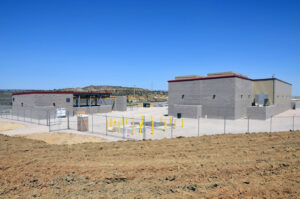 The construction, which began in 2012, is currently active along several fronts of the project. The project essentially consists of 2 separate pipelines. Each pipeline serves a different area of the Navajo Nation, which is why there are two water treatment plants. Construction is currently underway on both laterals, the Cutter Lateral and the San Juan Lateral. The first water delivery is set for the Cutter Lateral for the end of 2020. The full project construction is expected to be completed by 2024, which is also the congressionally mandated deadline. The current estimated cost of the project is approximately $1.16 billion, at the October 2018 price level.
The construction, which began in 2012, is currently active along several fronts of the project. The project essentially consists of 2 separate pipelines. Each pipeline serves a different area of the Navajo Nation, which is why there are two water treatment plants. Construction is currently underway on both laterals, the Cutter Lateral and the San Juan Lateral. The first water delivery is set for the Cutter Lateral for the end of 2020. The full project construction is expected to be completed by 2024, which is also the congressionally mandated deadline. The current estimated cost of the project is approximately $1.16 billion, at the October 2018 price level.
As I mentioned, this is part of the Navajo Water Rights Settlement Agreement, so the Navajo Nation’s share of the costs is forgiven and paid for by the United States. We do have two other project participants, the City of Gallup and the Jicarilla Apache Nation, that will benefit from the project. They both have the obligation to repay a portion of their allocated construction costs, and so they are prepaying those costs to avoid incurring interest during construction. In addition, the State of New Mexico, as a signatory to the Water Rights Settlement Agreement, is obligated to provide $50 million in cost-share toward the project.
Tyler Young: You mentioned that there was a federally mandated completion date. Why is that?
Patrick Page: We have a completion deadline and we also have an appropriations ceiling—in other words, we have a limited amount of money and a limited amount of time to get the project completed. The deadline is for everyone: No one wants a lingering project that is never completed. We want to cross the finish line and meet our obligations to the Navajo Nation as far as the settlement goes. It does create its own challenges: We are building this project not only to meet current demands but to meet future demands. We are designing and constructing the project around a 2040 population projection, but it has to be functional and operational by 2024. It is going to be oversize until that future demand comes to fruition.
Tyler Young: You mentioned that the project covers an area the size of New Jersey. How many people live in that area?
Patrick Page: A rough estimate of the current population in the service area would be around 125,000.
Tyler Young: How many people will the project serve?
Patrick Page: The project is designed to provide enough water to serve a 2040 population of approximately 250,000 people. It’s important to note that the water won’t all be going to individual residences. One of the main purposes of this project is to spur economic development opportunities on the Navajo Reservation, so we expect large commercial and industrial users as well.
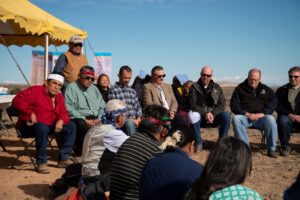 Tyler Young: What initiatives and projects are you completing at the moment?
Tyler Young: What initiatives and projects are you completing at the moment?
Patrick Page: As I mentioned, we have started construction on several fronts. We are building this project in reaches, or sections. Right now, Reclamation has two active pipeline contracts going, one on each lateral. Construction of our first water treatment plant is scheduled to start in early November. We are also working with partners on this project that are receiving funding from Reclamation through financial assistance agreements. Through these agreements, the Navajo Nation, the City of Gallup, and the Indian Health Service are designing and constructing certain features of the project. There is construction going on with those entities as well. We maintain the overarching responsibility for the completion of the project, but we work with others through these financial assistance agreements to allow us to meet that 2024 deadline. I always tell people that when we started, 2024 sounded like a date from a futuristic sci-fi movie, but now it is just 6 years away.
I should mention that all the design for the Reclamation-constructed portions of the project is being done out of our technical services center in Denver. The only exceptions are the water treatment plants: Those will be designed and constructed through the design-build process. We currently have a contractor on board for the Cutter Water Treatment Plant, where construction will begin in November 2018. The design-build contract for the San Juan Water Treatment Plant, a much bigger plant, will be awarded in late 2019 or early 2020.
One of the most interesting aspects of this project is the spiritual and cultural element. The phrase “water is life” carries with it a special and deep meaning in Indian country. We as an agency are trying to be sensitive to that; we are trying to do what we can to respect and protect those spiritual beliefs. Before we break ground on the water treatment plants, we’ll be participating in a traditional blessing ceremony on the site. That just goes to show the cultural and spiritual significance of what we are doing. It is important to the Navajo tribal members, and we try to do what we can to respect and protect those beliefs.
Along those lines, for the first time in Reclamation’s history, we have hired a Navajo public-outreach coordinator. One of the requirements of that position is to be bilingual in English and Navajo. Most of the meetings that we attend on the reservation are conducted, at least in part, in the Navajo language. With the help of our outreach coordinator, we are able to better communicate at these functions. Also, a group of us in the office have learned how to introduce ourselves in Navajo—with help, of course. It has been a great way for us to show respect and it has been a great icebreaker too. I struggle through it, but each time I have introduced myself in Navajo, I’ve gotten applause from pretty much everyone in the meeting. Tribal members and tribal government folks have been very positive in their reactions to this, and it helps in building trust and earning respect. That is a unique part of this project, and it reflects the bigger things that this project is about.
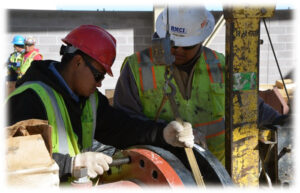 Tyler Young: What are some of the biggest challenges you are facing?
Tyler Young: What are some of the biggest challenges you are facing?
Patrick Page: We have a lot of challenges, a lot of bumps in the road—every day, it seems. The great thing about this project, though, is that we have continued to move forward; no bump in the road has turned into a roadblock. Going from an appraisal-level design to a final design has been a big challenge. The project was authorized in 2009, and at that time we only had an appraisal design—an estimate. With our 2024 deadline, we had to get right to work, even though there was still some administrative work left to do. We still had to complete the environmental impact statement (EIS), for one thing. We also recognized that we did not have the time or the financial resources to follow the normal Reclamation process of taking the appraisal-level design to the feasibility level, and then taking that and making it a final design. We are having to go from not much more than a line drawn on a map showing the proposed pipeline alignment, with little to no design data from the field, to a final design and specifications in 2½ years. That has been a challenge because as we get out in the field and start obtaining design data, new information becomes available and we have to tweak our alignment. It might mean that we have to go back and do additional cultural-resource surveys, or geologic surveys, or revise our right-of-way needs. The designers then have to revise their designs. It really has a snowball effect.
I mentioned earlier that we are designing the project to have capacity for future projected growth, but we have to have it completed and capable of delivering water by 2024, whatever the demand is. That leads to some engineering and water quality challenges. We have to factor all that in.
This is a drinking water project, and historically Reclamation has not been involved in the treatment of water. Historically, we have provided raw water to a municipality or a water provider, which then has the responsibility to treat and deliver it to its customers. In this case, we are treating the water, passing it down the system, and then dropping it off for the municipalities and utilities to deliver. We are not in the water delivery business, but with this project, we are very much in the water treatment business. Along those lines, we have to deal with multiple regulatory agencies when it comes to compliance with drinking water regulations: two U.S. Environmental Protection Agency Enviornmental Protection Agency regions, the Navajo Enviornmental Protection Agency, and the New Mexico Environmental Department. There are a lot of folks in the room when we have regulatory meetings.
Cultural resources compliance is another challenge for us. We are in the Four Corners region, known for places like Mesa Verde National Park and Chaco Canyon National Historic Park. It is the archaeological epicenter of the United States. Cultural resources compliance wasn’t completed prior to authorization of the project, so that is something that we are having to clear on the way, in some cases immediately prior to construction. That puts a lot of pressure on us. Also, we’re not just working with the Navajo Nation on cultural resources compliance, even though it is on their reservation. We’re also coordinating with over 20 other tribes in the region that have an interest in the area, along with all the different state and federal agencies that are responsible for ensuring compliance with various cultural resources regulations.
Another challenge is obtaining rights of way for this 300-mile pipeline project. The legislation actually requires the participants—the Navajo Nation, the City of Gallup, and the Jicarilla Apache Nation—to donate any land that is needed for the construction and operation of the project. Since a majority of this land is on the reservation and is mostly Navajo Nation land, there is no cost there, but we still have to go through the land-acquisition process. The Navajo Trust land is held in trust by the Bureau of Indian Affairs, and acquiring it involves a two-step process. First you have to get consent from the Navajo Nation, and then you have to submit a right-of-way application to the Bureau of Indian Affairs and go through its review and approval process. We also have private parcels, state lands, and other federal lands, and all these other lands have different requirements and different processes. In some cases, there are state statutes regarding land acquisition that directly conflict with federal land acquisition laws. We have been working through all those issues. Fortunately, the people we work with in the other agencies have an appreciation for and an understanding of the significance of this project, and we’ve been able to work through all our conflicts thus far.
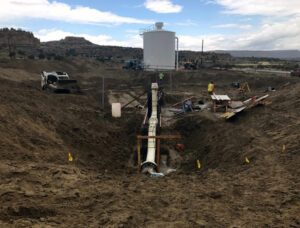
The last challenge is that we always have to be mindful of the appropriations ceiling associated with the project, as well as the congressionally mandated deadline of 2024.
Tyler Young: Where do you see the water supply industry going in the future?
Patrick Page: This project is an unusual one for Reclamation in the current day because it is the construction of a large-scale water development project. Reclamation’s mission has really shifted to focus on operating, maintaining, and managing our existing facilities, and also figuring out how to modernize our aging infrastructure. Navajo-Gallup, by contrast, is a brand-new project, harkening back to the days when Reclamation was a big construction agency. I don’t really come from a construction background, so this has been new to me, but it is rewarding. I believe our staff shares that feeling as well, because we all know that the big reward will come at the end of the project when we are able to see Navajo tribal members getting water at their homes, in many cases for the first time.
Tyler Young: What advice do you have for your peers in the industry?
Patrick Page: Having taken on a project of this magnitude, even as a federal agency, we work with a multitude of tribal, local, state, and federal agencies to make it happen. This project is not shy on having meetings. We have a lot of them—but that is because we need them. It takes a lot of coordination and sometimes it takes some hand-holding. There are politics involved, and because of past broken promises that we had nothing to do with, there is an inherent lack of trust when it comes to the federal government. All that coordination, cooperation, and perseverance is essential to getting something like this built. Even with the challenges that we face, it is a great project to work on, because we know what it means for the Navajo Nation, the Jicarilla Apache Nation, and the City of Gallup. We know that the challenges are going to be worth the rewards. We are bringing a clean and reliable water supply to people who currently do not have it. The purpose of this project is not to find an additional water supply to meet the increased demand of a sprawling metropolitan area. It is quite the opposite: It aims to bring water to people who live in this country but do not have access to water. To say that this project is going to have a positive effect on the Navajo Nation, the Jicarilla Apache Nation, and the City of Gallup is a huge understatement. It is going to have an incredible effect and will give the project beneficiaries great opportunities for economic advancement for decades to come. This project will make a difference. Everyone involved knows that they have a role in reaching the end goal of delivering clean reliable water to people, and that is something that makes all the hard work worthwhile.
Tyler Young: Could you please describe how people in the project area are currently getting their water?
Patrick Page: Some houses are hooked up to distribution systems that are supplied by groundwater; others haul their water from water stations. Currently, there is no surface water source. The groundwater is of limited quantity and is in many cases questionable in terms of quality. This project will replace that groundwater with a clean and reliable surface water supply and will provide a water supply for individuals who currently don’t have any water coming to their homes and have to haul it in from various locations.
Tyler Young: Is there anything else that you would like to add?
Patrick Page: We always like to tell the people whom we interact with on a day-to-day basis that this project is not a pipeline going through your community—it is a pipeline coming to your community. We are providing water to the Navajo Nation to help it for the future. It is an exciting time, because 8 years ago, when we’d be giving presentations on the project in communities in the project area, the audience was skeptical. Now, when we go to these meetings, I just tell folks to look outside and they’ll see construction equipment putting pipe in the ground. This project is definitely becoming a reality, and it will soon be providing the benefit that so many people have waited so long for.
For more information on the Navajo-Gallup Project, please visit https://www.usbr.gov/uc/.
